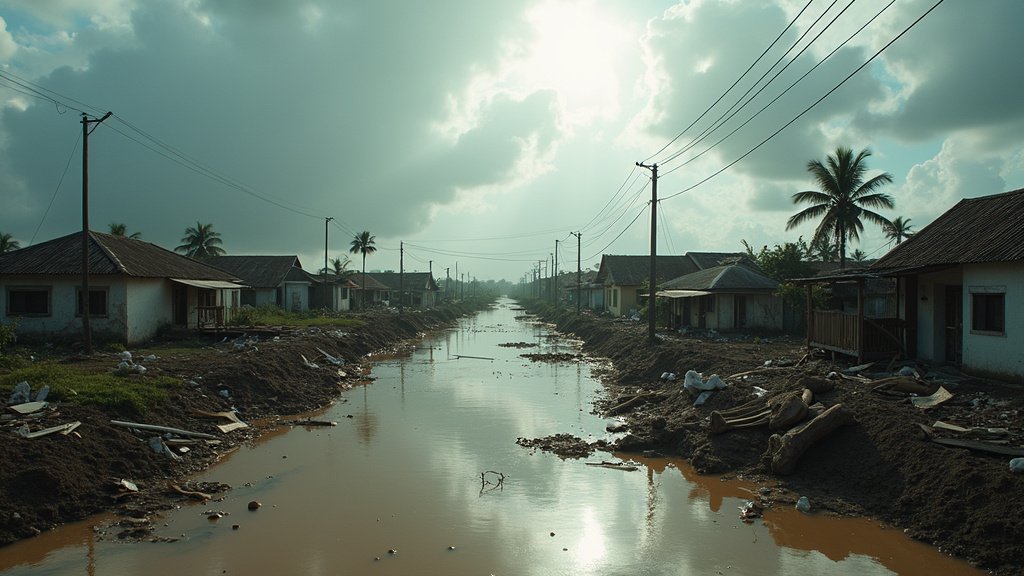Jamaica is grappling with unprecedented devastation in the wake of Hurricane Melissa, a monstrous Category 5 storm that made landfall on October 28, 2025, unleashing catastrophic winds, widespread flooding, and a devastating storm surge. This event marks one of the most powerful hurricanes ever recorded to strike the island nation, and the impact of Hurricane Melissa Jamaica will be felt for years to come.
Hurricane Melissa’s Unrelenting Fury on Jamaica
Hurricane Melissa made landfall near New Hope, Jamaica, with sustained winds of 185 miles per hour, a strength rarely seen in the Atlantic basin. The storm’s immense power, described as the strongest hurricane to ever hit Jamaica, subjected the island to life-threatening winds and torrential rainfall, estimated to be up to 500 mm in several areas. Its slow movement further compounded the destructive impact, leading to severe Jamaica flooding, landslides, and prolonged exposure to its fury. The storm also impacted other Caribbean nations, with Haiti reporting a significant number of fatalities from this Caribbean disaster.
Devastation Across Jamaica from Hurricane Melissa
The southwestern and western parishes of Jamaica bore the brunt of Melissa’s impact. Communities like Black River, now declared “ground zero” by Prime Minister Andrew Holness, have been decimated, with up to 90% of structures reportedly destroyed or severely damaged. Roads have been rendered impassable by landslides and flooding, isolating communities and hampering critical rescue and relief efforts. Essential infrastructure has suffered extensive damage; hospitals, including Black River Hospital which lost part of its roof, and schools have been heavily impacted, severely limiting access to healthcare and education services. Widespread power outages have affected approximately 66% to 77% of the island, with communication networks also severely disrupted, complicating damage assessment and relief coordination. The Hurricane Melissa Jamaica crisis is far-reaching.
The human toll has been tragic, with the confirmed death toll in Jamaica steadily rising. Reports indicate at least 19 fatalities, though authorities acknowledge this number is likely to increase as search and recovery operations continue in accessible areas. Beyond the confirmed deaths, thousands of people have been displaced, with around 30,000 individuals estimated to be homeless and seeking refuge in emergency shelters across the island. The Hurricane Melissa Jamaica disaster has left many without homes.
Economic Fallout and Long-Term Recovery for Jamaica
Beyond the immediate humanitarian crisis, Hurricane Melissa’s impact poses a severe threat to Jamaica’s economic stability. Preliminary assessments suggest the total economic impact could range from 30% to 250% of the island’s Gross Domestic Product (GDP), potentially triggering a deep recession, widespread unemployment, and significant strain on financial institutions. The vital tourism and agricultural sectors, key pillars of Jamaica’s economy, have been particularly hard-hit by the Hurricane Melissa Jamaica storm. Farmers have seen crops flattened, and fishing communities have reported destruction of boats and livelihoods, exacerbating existing food security concerns.
National and International Response to Hurricane Melissa Jamaica
In the face of this catastrophe, the Government of Jamaica declared the island a “disaster area” and mobilized its resources, supported by the Caribbean Disaster Emergency Management Agency (CDEMA), UN agencies, and international partners. The World Food Programme (WFP) is actively involved in coordinating logistics and providing food assistance, while the International Federation of Red Cross and Red Crescent Societies (IFRC) has dispatched essential supplies like shelter kits and tarpaulins. The United States has deployed urban search-and-rescue teams and military helicopters for humanitarian aid, and other nations, including Japan and the UK, have pledged financial and material support. The UN has allocated $4 million from its Central Emergency Response Fund (CERF) to bolster humanitarian operations. Recognizing the need for swift financial liquidity, Jamaica has access to significant funds through its robust disaster risk financing strategy, including a $150 million catastrophe bond and a record $70.8 million payout from CCRIF SPC, an initiative designed to provide rapid post-disaster financial support for the Hurricane Melissa Jamaica aftermath.
The Road Ahead for Jamaica Post-Hurricane Melissa
Rebuilding from Hurricane Melissa will be a monumental task, expected to take years and requiring sustained international cooperation and investment. The destruction has highlighted the Caribbean’s vulnerability to increasingly severe climate-related events and underscores the critical importance of resilience-building measures. As Jamaica begins the arduous process of recovery from this record storm, the focus remains on restoring essential services, providing immediate relief to affected populations, and laying the groundwork for a long-term reconstruction effort that can withstand future climatic shocks.

